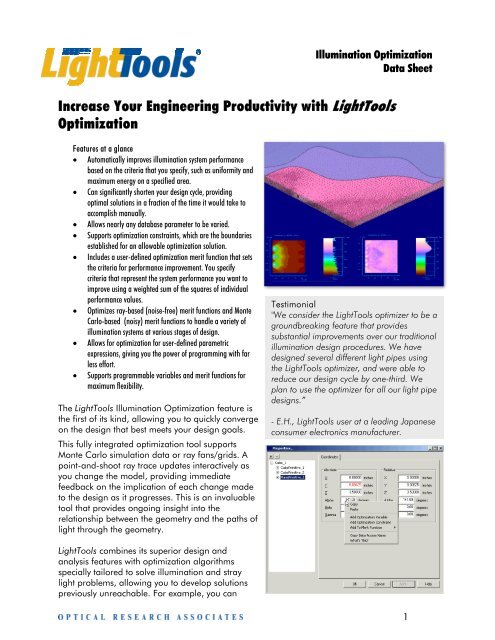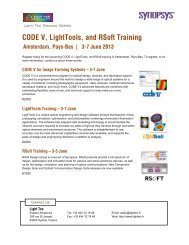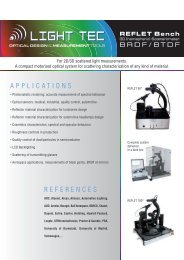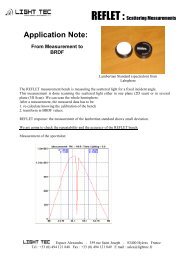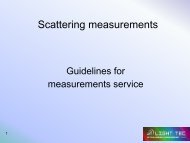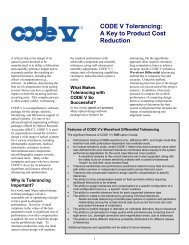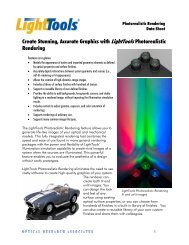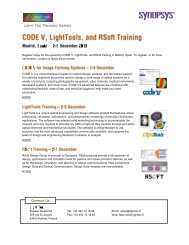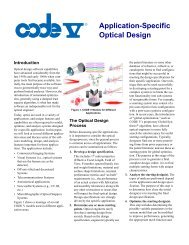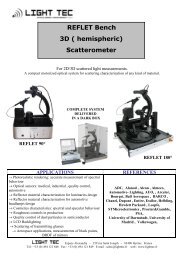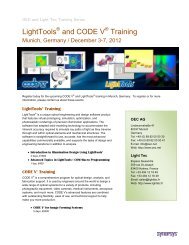Optimisation with LightTools - Light Tec
Optimisation with LightTools - Light Tec
Optimisation with LightTools - Light Tec
You also want an ePaper? Increase the reach of your titles
YUMPU automatically turns print PDFs into web optimized ePapers that Google loves.
Illumination Optimization<br />
Data Sheet<br />
Increase Your Engineering Productivity <strong>with</strong> <strong><strong>Light</strong>Tools</strong><br />
Optimization<br />
Features at a glance<br />
• Automatically improves illumination system performance<br />
based on the criteria that you specify, such as uniformity and<br />
maximum energy on a specified area.<br />
• Can significantly shorten your design cycle, providing<br />
optimal solutions in a fraction of the time it would take to<br />
accomplish manually.<br />
• Allows nearly any database parameter to be varied.<br />
• Supports optimization constraints, which are the boundaries<br />
established for an allowable optimization solution.<br />
• Includes a user-defined optimization merit function that sets<br />
the criteria for performance improvement. You specify<br />
criteria that represent the system performance you want to<br />
improve using a weighted sum of the squares of individual<br />
performance values.<br />
• Optimizes ray-based (noise-free) merit functions and Monte<br />
Carlo-based (noisy) merit functions to handle a variety of<br />
illumination systems at various stages of design.<br />
• Allows for optimization for user-defined parametric<br />
expressions, giving you the power of programming <strong>with</strong> far<br />
less effort.<br />
• Supports programmable variables and merit functions for<br />
maximum flexibility.<br />
The <strong><strong>Light</strong>Tools</strong> Illumination Optimization feature is<br />
the first of its kind, allowing you to quickly converge<br />
on the design that best meets your design goals.<br />
This fully integrated optimization tool supports<br />
Monte Carlo simulation data or ray fans/grids. A<br />
point-and-shoot ray trace updates interactively as<br />
you change the model, providing immediate<br />
feedback on the implication of each change made<br />
to the design as it progresses. This is an invaluable<br />
tool that provides ongoing insight into the<br />
relationship between the geometry and the paths of<br />
light through the geometry.<br />
Testimonial<br />
"We consider the <strong><strong>Light</strong>Tools</strong> optimizer to be a<br />
groundbreaking feature that provides<br />
substantial improvements over our traditional<br />
illumination design procedures. We have<br />
designed several different light pipes using<br />
the <strong><strong>Light</strong>Tools</strong> optimizer, and were able to<br />
reduce our design cycle by one-third. We<br />
plan to use the optimizer for all our light pipe<br />
designs.”<br />
- E.H., <strong><strong>Light</strong>Tools</strong> user at a leading Japanese<br />
consumer electronics manufacturer.<br />
<strong><strong>Light</strong>Tools</strong> combines its superior design and<br />
analysis features <strong>with</strong> optimization algorithms<br />
specially tailored to solve illumination and stray<br />
light problems, allowing you to develop solutions<br />
previously unreachable. For example, you can<br />
1
Illumination Optimization Data Sheet<br />
optimize your system to match<br />
a target illumination<br />
distribution, maximize flux on<br />
the receiver, or meet other<br />
user-defined criteria.<br />
Adding variables, constraints,<br />
and merit functions is easy to<br />
do from <strong><strong>Light</strong>Tools</strong> dialog<br />
boxes, using context menus displayed when you right-click the mouse. Almost any numeric field<br />
<strong>with</strong>in the <strong><strong>Light</strong>Tools</strong> user interface can be added as a variable, constraint, or used as part of the<br />
merit function. Additionally, all of the optimization components are conveniently organized for<br />
viewing and editing in the Optimization Manager.<br />
Once you add a variable as an active component of the optimization, <strong><strong>Light</strong>Tools</strong> helps you select<br />
appropriate variable boundaries and increments by providing intelligent defaults, a hallmark of<br />
Optical Research Associates’ software. Constraints are defined in terms of a mathematical<br />
relationship (i.e., ) between the value of a parameter and a target value.<br />
Constrainable parameters include both model parameters (such as positions and orientations of<br />
entities) and analysis results (such as receiver total power or CIE coordinates).<br />
The user-defined optimization merit<br />
function sets the criteria for performance<br />
improvement. You specify the criteria that<br />
represent the system performance you<br />
want to improve using a weighted sum of<br />
the squares of individual performance<br />
values. A merit function item is added to<br />
the optimization problem in the same easy<br />
way a variable or constraint is added: by<br />
selecting the desired field and rightclicking<br />
to display the context menu. Merit<br />
functions can be comprised of more than<br />
one group, and each group can include<br />
multiple items. Each item in a group can<br />
have a different target and weight, and<br />
you can enable or disable individual items.<br />
Each group can also be weighted and enabled or disabled to control its influence on the<br />
optimization solution. These options allow for a degree of flexibility no other optimizer possesses.<br />
In addition, all of the merit function groups are displayed in a well-organized summary table.<br />
This allows rapid access to all of the components of the merit function at once.<br />
The proprietary algorithms <strong>with</strong>in the <strong><strong>Light</strong>Tools</strong> optimization engine use all of the optimization<br />
components to find a solution to the problem. Optimization essentially minimizes the merit<br />
function by changing the defined variables and simultaneously satisfying the specified constraints.<br />
<strong><strong>Light</strong>Tools</strong> manages the optimization progress using built-in criteria such as exit controls and<br />
noise calculations, which intelligently balance accuracy and efficiency.<br />
If you are interested in trying <strong><strong>Light</strong>Tools</strong> and the new Optimization Module, please contact<br />
Optical Research Associates at (626) 795-9101, visit www.opticalres.com, or e-mail us at<br />
info@opticalres.com.<br />
2


